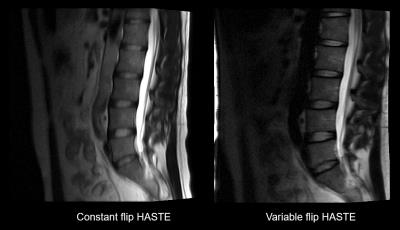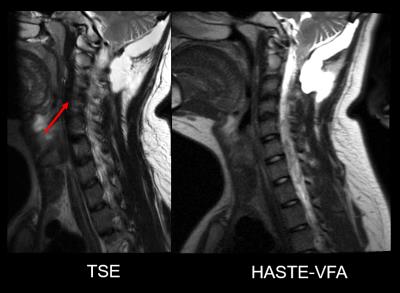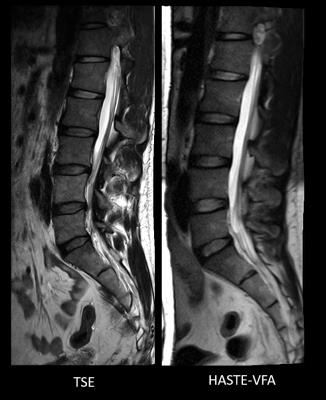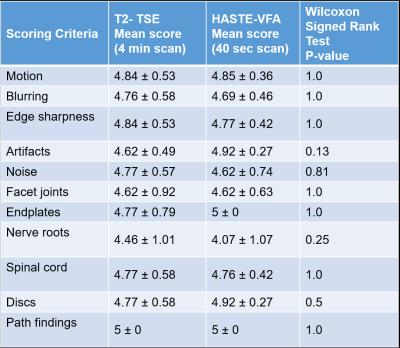0538
Clinical utility of a novel ultrafast T2 Weighted sequence for Spine Imaging1Electrical and Computer Engineering, University of Arizona, Tucson, AZ, United States, 2Medical Imaging, University of Arizona, Tucson, AZ, United States
Synopsis
T2 weighted imaging of the spine is commonly performed using Turbo Spin Echo (TSE) sequences, resulting in long scan times and vulnerability to motion artifacts. While the single-shot sequences such as HASTE could be used for rapid screening, their use is limited by poor spatial resolution and SAR limitations. We investigated the use of a variable flip angle HASTE (HASTE-VFA) sequence for ultrafast motion robust T2 weighted spine imaging and compared its performance to T2 TSE in 13 patients.
Introduction
T2 weighted imaging of the spine is commonly performed using Turbo Spin Echo (TSE) sequences, resulting in long scan times and vulnerability to motion artifacts. While the single-shot sequences (HASTE, SSFSE) could be used for rapid screening, their use is limited by poor spatial resolution and SAR limitations. Recently, a variable refocusing flip angle SSFSE sequence was successfully demonstrated for abdominal and pelvic imaging [1,2,3] with reduced SAR and blurring. We investigated the use of a variable flip angle HASTE (HASTE-VFA) sequence for ultrafast motion robust T2 weighted spine imaging and compared its performance to T2 TSE in 13 patients.Methods
A commercial Siemens HASTE sequence was modified to incorporate the refocusing flip angle modulation scheme proposed by Busse et al. [4]. The flip angles were optimized to maximize the SNR for the desired effective TE and subsequently minimize SAR with minimal spatial blurring. Readout flow compensation was used to reduce CSF pulsation artifacts. Since the T2 decay effects are prolonged and SAR is minimized in variable flip angle sequences, a partial Fourier factor of 0.75 was used to achieve the desired effective TE of 105 msec. A slice concatenation factor of 3 or 4 was used to reduce inter-slice cross talk artifacts.
The sequence was implemented and tested on a Siemens 3T (Skyra) scanner. Volunteer data was acquired using the constant flip angle HASTE and the HASTE-VFA sequences to study the effect of blurring and to optimize the sequence parameters. The sequence was added to clinical spine protocols at our institution in addition to the routine T2 weighted TSE sequence. With the approval of the Institutional Review Board and with informed consent, data was acquired from 13 patients. The HASTE-VFA sequence was run at a 600 Hz/pixel readout bandwidth, 1.0x0.8x3.0 mm acquisition resolution (resulting in a 0.5x0.5x3.0 mm image resolution) for the L-spine protocol and at the sequence limited TR value. This resulted in a total acquisition time of 40 seconds for 3 averages, with a partial Fourier factor of 0.75 and no parallel imaging. In comparison, the TSE sequence had a typical acquisition time of 4 minutes for 2 averages.
The image quality of the HASTE-VFA and the TSE sequences was assessed by a neuroradiologist. Scores in the range of 1-5 were assigned based on the following 11 criteria : effects of motion, blurring, edge sharpness, artifacts, noise and the ability to interpret facet joints, endplates, nerve roots, spinal cord, discs and path findings. A score of 1 corresponded to non-diagnostic images, with 5 being the optimal image quality for diagnosis. A Wilcoxon signed rank test was performed to determine if the performance of the two sequences varied significantly from each other.
Results
Figure 1 shows L-spine images from the constant flip angle and the variable flip angle HASTE sequences. It can be observed that blurring is significantly reduced in the variable flip angle sequence due to the improved PSF behavior resulting from the modulation of the T2 signal decay. The effect of subject motion in long TSE sequences are illustrated in Figures 2 and 3. Figure 2 shows a cervical-spine image where the 4-minute-long TSE sequence exhibits severe motion artifacts. This is eliminated in the shorter (40 sec) HASTE-VFA scan. The thoracic-spine images in Figure 3 also show motion blur in the TSE scan. We can observe that the HASTE-VFA generates images with comparable contrast to the TSE, albeit at a slightly lower resolution. Figure 4 illustrates the application of the variable flip angle sequence for lumbar-spine imaging. The results of the radiologist grading are shown in Figure 5. The mean scores assigned to the TSE and the HASTE-VFA sequence for the 11 image quality criteria are listed along with the P-values from the Wilcoxon signed rank test. There were no significant differences in image quality between the two sequences for any of the 11 criteria. This motivates the ability to use HASTE-VFA as a quick screening sequence for emergency protocols and as an add-on to the routine spine protocols to aid in diagnosis when traditional TSE sequences are affected by motion.Conclusion
We present a fast and motion robust T2 weighted spine protocol using the variable flip angle HASTE sequence. The sequence has better PSF behavior than the constant flip angle variant and being a quick scan it is insensitive to patient motion, often seen in the longer TSE scans. This would enable the use of the sequence in spine screening protocols.Acknowledgements
No acknowledgement found.References
[1] Litwiller DV, Holmes JH, Saranathan M, et al. Sensitivity of modulated refocusing flip angle single-shot fast spin echo to impulsive cardiac-like motion. In: Proc 22nd Annual Meeting ISMRM, Milan; 2014
[2] Loening AM, Litwiller DV, Saranathan M, et al. Increased speed and image quality for pelvic single-shot fast spin-echo imaging with variable refocusing flip angles and full-fourier acquisition. Radiology 2016 Aug 26:151574. Epub 2016 Dec 26.
[3] Loening AM, Saranathan M, et al. Increased Speed and Image Quality in Single-Shot Fast Spin Echo Imaging Via Variable Refocusing Flip Angles. JMRI 2015 42 : 1747-1758
[4] Busse RF, Brau A, Vu A, et al. Effects of refocusing flip angle modulation and view ordering in 3D fast spin echo. Magn Reson Med 2008; 60:640–649
Figures




